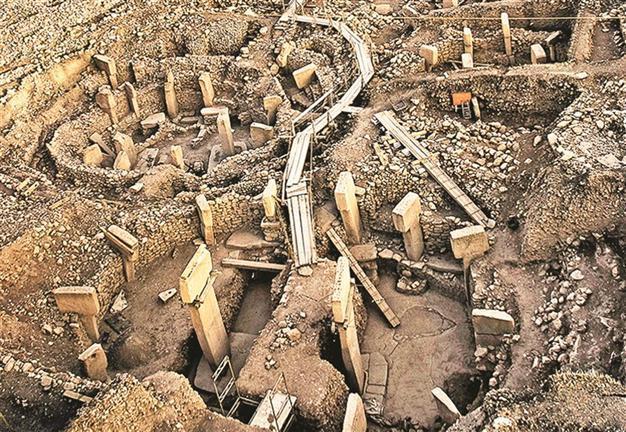Birthplace of religion Göbeklitepe aims for more recognition
ŞANLIURFA - Hürriyet Daily News

A campaign in the southeastern province of Şanlıurfa aims to promote Göbeklitepe,which scientists believe is home to the world’s oldest temple.
Humankind is believed to have first met organized religion in Anatolia, and now the aim is to make this known by many more people.A campaign was launched in the southeastern province of Şanlıurfa yesterday to promote Göbeklitepe, which scientists believe is home to the world’s oldest temple.
As part of the campaign, an exhibition of ceramic tiles carrying the photographs of the objects found in the 12,000-year-old temple was opened Nov. 24 at the Kemalettin Gazezoğlu Culture and Arts Center. Sponsored by Doğuş Holding, the exhibition, opened by Labor Minister Faruk Çelik, will come to Istanbul in February. A website, www.gobeklitepeturkey.org, was also launched simultaneously.
Ece Vahapoğlu, the coordinator of the campaign, told a group of journalists invited to the opening ceremony that the importance and beauty of Göbeklitepe should be known by more people. “The mystic structure of Şanlıurfa captivates us all, and Göbeklitepe has a special place in our hearts,” she said. “I hope that everybody who visits Göbeklitepe will share our excitement,” Vahapoğlu added, thanking the sponsors who made the project possible.

An exhibition of photographs of the objects
found in the 12,000-year-old Göbeklitepe is
on view at the Kemalettin Gazezoğlu Culture
and Arts Center. DHA photo
Göbeklitepe, whose planners and builders remain a mystery, consists of not only one, but of many Stone Age temples. Excavations and geomagnetic results revealed that there are at least 20 installations, which in archeological terms can be called a temple. The pattern principle seems to be that there are two huge monumental pillars in the center of each installation, surrounded by enclosures and walls, featuring more yet more pillars. All pillars are T-shaped and of varying height, ranging from three to six meters, while averaging about 40 to 60 tons in weight. On the pillars are carvings of animals as well as abstract symbols, sometimes picturing a combination of scenes.
Foxes, snakes, wild boars, cranes, wild ducks are the most commonly figures inscribed on the flat surfaces of the pillars. In addition to the carving are some three-dimensional sculptures that take the shape of a predator depicting a lion, descending on the side of the T-pillar.
Discovered in 1963
The site was first discovered in 1963, but it was not until 1995 that the importance of it became known. Since then, Professor Klaus Schmidt has been heading the excavations in Göbeklitepe: “There were many settlements of hunter-gatherer societies,” he said. “Göbeklitepe was a worship center for those people. The builders of the temple were the first ones to ask ‘what is the universe?’ and ‘why are we here? First came the temple, and then came the city.”
As the excavations and works on the findings continue, it is still unknown as to how these enclosures were designed and built at a time when people were unaccustomed to and unfamiliar with settlement and agricultural activities. Humankind’s history may be rewritten when those questions become answered.
















